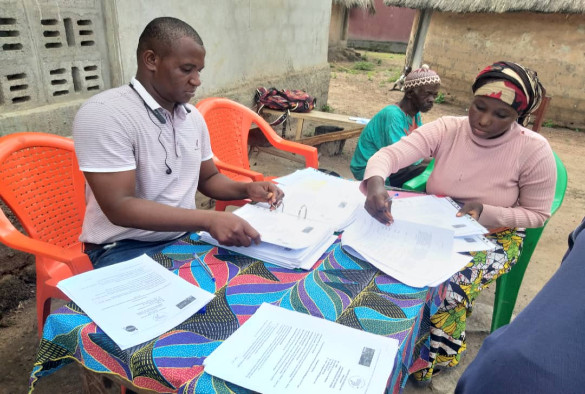
Researchers at the University of Liverpool and the University of Oxford have for the first time been able to estimate the current burden of Lassa fever, project the impacts of a Lassa fever vaccination programme and demonstrate how it may help avoid the next pandemic. The study is published in Nature Medicine and has been funded by the Coalition for Epidemic Preparedness Interventions (CEPI).
Lassa fever is an emerging viral illness caused by the Lassa virus that is currently endemic in many countries in West Africa, meaning that the majority of cases only occur within these areas. However, the World Health Organization (WHO) has expressed concerns that due to a current lack of effective vaccines and treatments the next pandemic could be caused by a Lassa-related virus.
The researchers estimated the current health and economic burden of Lassa fever throughout West Africa and looked at the potential impact of six different vaccination approaches, developed by study co-authors at Linksbridge SPC. The approaches focused on large-scale preventive vaccination programmes that would be rolled out over three years across endemic regions.
Responding to concern around Lassa fever’s pandemic potential, the researchers also simulated the emergence and international spread of Lassa-X, a hypothetical pandemic variant of Lassa virus. They then evaluated how achieving the target set in the 100 Days Mission to develop and deploy a safe and effective vaccine within 100 days of the next pandemic threat emerging could mitigate the health and economic burdens of a potential Lassa-X pandemic.
In both models, the researchers looked at the number of infections, hospitalisations, deaths and disability-adjusted life years (DALYs) that could be averted by vaccination. DALYs refer to the number of life-years lost due to ill-health, disability, or early death.
The researchers found that:
- There are an estimated 2.7 million Lassa virus infections in West Africa every year, resulting in about 200,000 DALYs annually;
- The most effective vaccination strategy was a population-wide preventative campaign primarily targeting areas where the virus is endemic;
- A population-wide preventative vaccination campaign could avert $20.1m in lost DALY value and $128.8m in societal costs;
- Reactive vaccination programmes in response to local outbreaks averted just one-tenth of the health-economic burden when compared with population-wide preventative campaigns;
- In the event of Lassa-X emerging, spreading throughout West Africa and causing approximately 1.2M lost DALYs within two years, deployment of a vaccine within 100 days would avert 22% of DALYs with a vaccine that is 70% effective against disease, and 74% of DALYs with a vaccine that is 70% effective against both infection and disease.
David Smith, Senior Researcher at Oxford Population Health’s Health Economics Research Centre and joint first author, said: “To our knowledge, this is the first burden of disease study for Lassa fever as well as the first to project impacts of Lassa vaccination campaigns on population health and economies.
“There are around 400 million people living in West Africa. One major potential benefit of present investment in Lassa vaccination development, not only to local populations but to people everywhere, is increased readiness to rapidly develop and deploy vaccines against future Lassa variants with pandemic potential.”
Dr Joanne Turner, research associate at the University of Liverpool and joint first author, said: “The Lassa vaccination campaigns included in our analysis were designed to reflect realistic assumptions about vaccine stockpile and administration, and as such included a constrained global vaccine stockpile (<20M doses annually) and limited allocation to districts not currently classified as endemic by WHO. Consequently, the impacts of our simulated Lassa vaccination campaigns were modest in countries other than Nigeria, Guinea, Liberia and Sierra Leone. Yet the data underlying our model suggest that there is likely already a significant burden of Lassa fever outside these countries.”
Déirdre Hollingsworth, Professor of Infectious Disease Epidemiology at the University of Oxford Big Data Institute, said: “Lassa fever predominantly affects low-income populations in rural areas and is likely to be highly underreported due to poor health access in these areas. This analysis highlights the potential impact of a vaccine in these populations.”
Richard Hatchett, CEO of CEPI, said: “Lassa fever is a serious public health problem in West Africa and is already threatened to spread to further regions as climate and environmental change increase epidemic risk. This study demonstrates the urgent need for a vaccine to protect people from this debilitating and so metimes deadly disease which we believe affects many more than those who are reported, due to limited access to diagnostics and healthcare. Lassa fever has been a priority for CEPI since our launch in 2017 and we are proud to be one of the world’s leading Lassa vaccine R&D funders.”
The study demonstrates that in every scenario, particularly in areas where the disease is endemic, preventative vaccination campaigns are more effective in reducing health and economic burdens of the disease, and are more cost-effective when compared with reactive vaccination in response to local outbreaks.
Image credit: CEPI